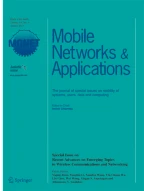Abstract
The evolution of wireless networks has motivated the expansion of the static business environment to a mobile and wireless one. However, current and forthcoming wireless technologies are characterized by different attributes, regarding coverage area, offered bandwidth and delay. The transparent conjunction of various wireless technologies into a single mobile terminal can further boost the wireless explosion. This paper presents the Wireless Convergence Architecture (WCA) that incorporates different wireless interfaces under the same mobile terminal. Depending on the location and the availability of the underlying wireless network, automatic and seamless switching is performed to the most appropriate wireless network interface. Special care is taken to maintain continuous connectivity at the transport layer (TCP). WCA introduces software components both at the terminal and network side. A specific implementation is presented, based on two complementary wireless technologies – in terms of coverage area – an IEEE 802.11-compliant in the short local and a GSM in the wide area. To demonstrate the operational correctness of the architecture, experiments were performed using standard and proprietary networking applications.
Similar content being viewed by others
References
IEEE Standard 802.11, Wireless LAN Medium Access Control (MAC) and Physical Layer (PHY) specifications (1997).
ETSI ETR 133, High Performance Radio Local Area Networks (HIPERLAN); System definition (July 1994).
DECT Forum, Digital Enhanced Cordless Telecommunications, http://www.dect.ch
ETSI Project – BRAN, http://www.etsi.org/bran/Summary.htm
A. Acampora, Wireless ATM: A perspective on issues and prospects, IEEE Personal Communications (October 1996).
ETSI TBR 019, European digital cellular telecommunications system (Phase 2), Attachment requirements for Global System for Mobile communications (GSM) mobile stations (March 1998).
ETSI EN 301 344 v7.4.1 (2000-09), General Packet Radio Service (GPRS), Service description, Stage 2 (GSM 03.60 version 7.4.1 Release 1998) (September 2000).
ETSI TS 101 038 V7.0.0, High Speed Circuit Switched Data (HSCSD), Stage 2 (GSM 03.34 version 7.0.0 Release 1998) (August 1999).
UMTS Forum, The path towards UMTS – Technologies for the information society (November 1998).
D. Plummer, An Ethernet address resolution protocol: Or converting network protocol addresses to 48 bit Ethernet addresses for transmission on Ethernet hardware, RFC 826 (November 1982).
W.R. Stevens, TCP/IP Illustrated, Vol.1, The Protocols (Addison-Wesley, Reading, MA, 1994).
C. Perkins, IP mobility support, RFC 2002 (October 1996).
Nationale Nederlanden, http://www.ing.gr/en/
W. Simpson, The Point-to-Point protocol (PPP) for the transmission of multi-protocol datagrams over point-to-point links, RFC 1331 (May 1992).
K. Pahlavan, P. Krishnamurthy, A. Hatami, M. Ylianttila, J. Makela, R. Pichna and J. Vallstrom, Handoff in hybrid mobile data networks, IEEE Personal Communications 7/2 (April 2000) 34–47.
Rights and permissions
About this article
Cite this article
Nikolaou, N.A., Vaxevanakis, K.G., Maniatis, S.I. et al. Wireless Convergence Architecture: A Case Study Using GSM and Wireless LAN. Mobile Networks and Applications 7, 259–267 (2002). https://doi.org/10.1023/A:1015499510588
Issue Date:
DOI: https://doi.org/10.1023/A:1015499510588
